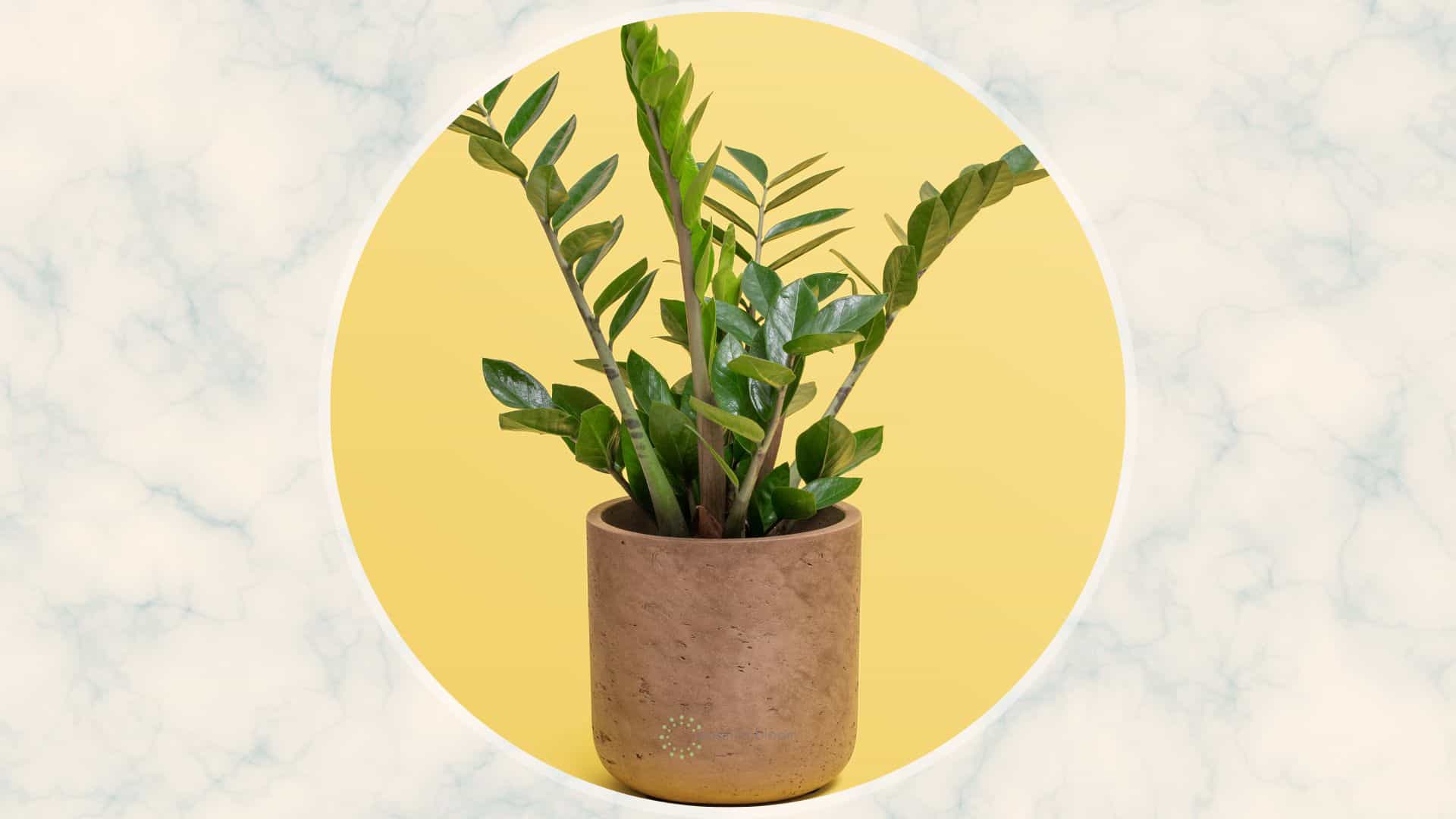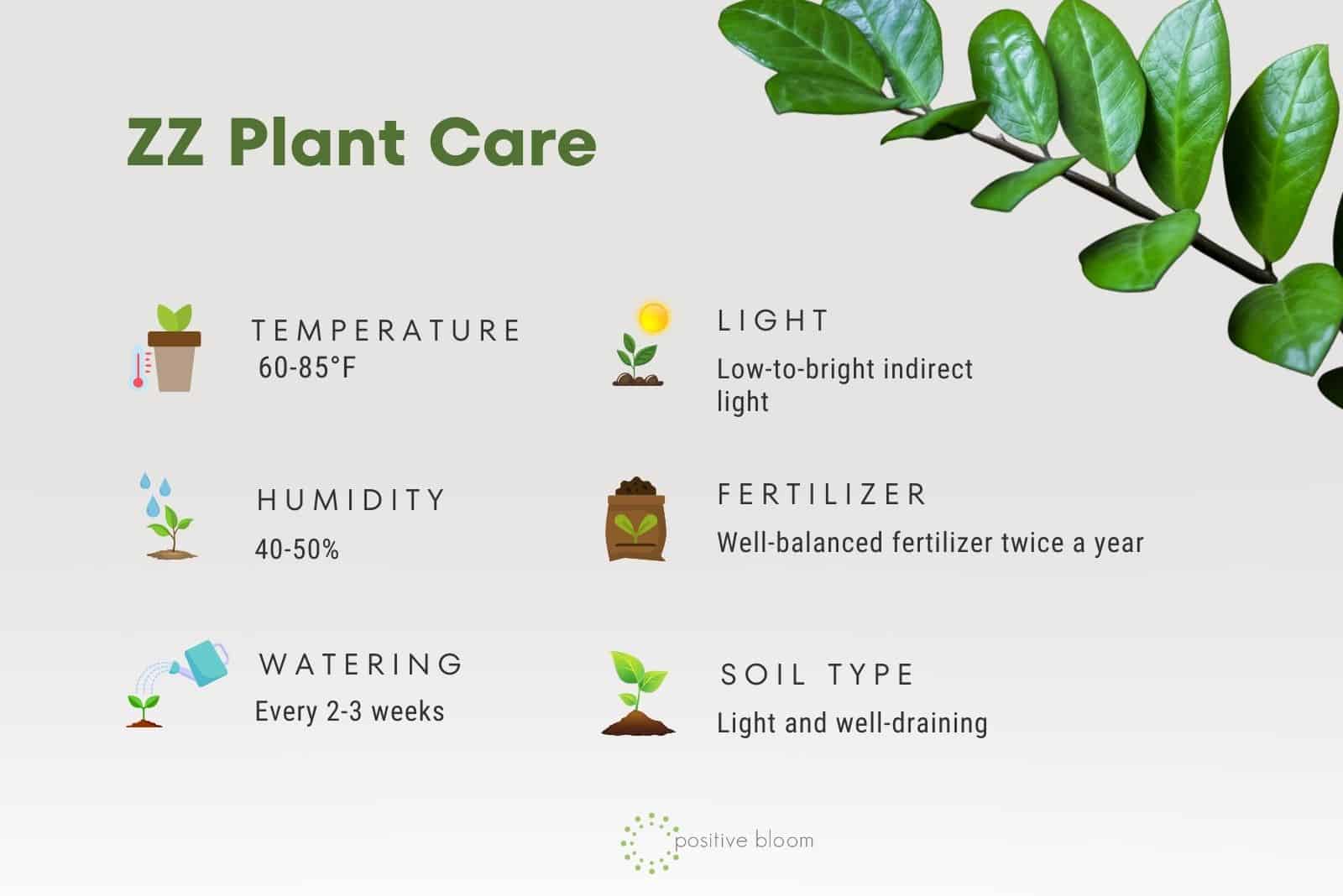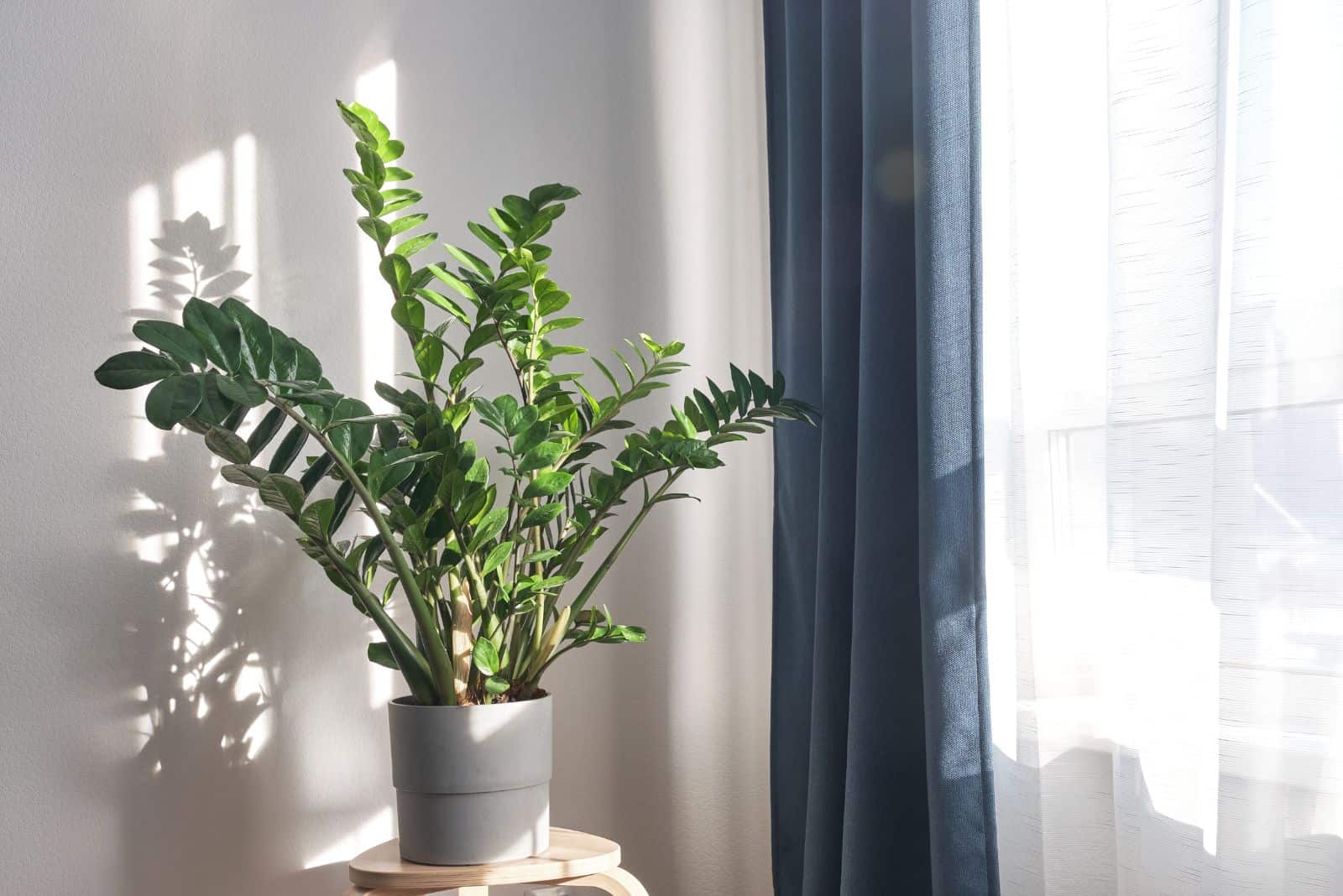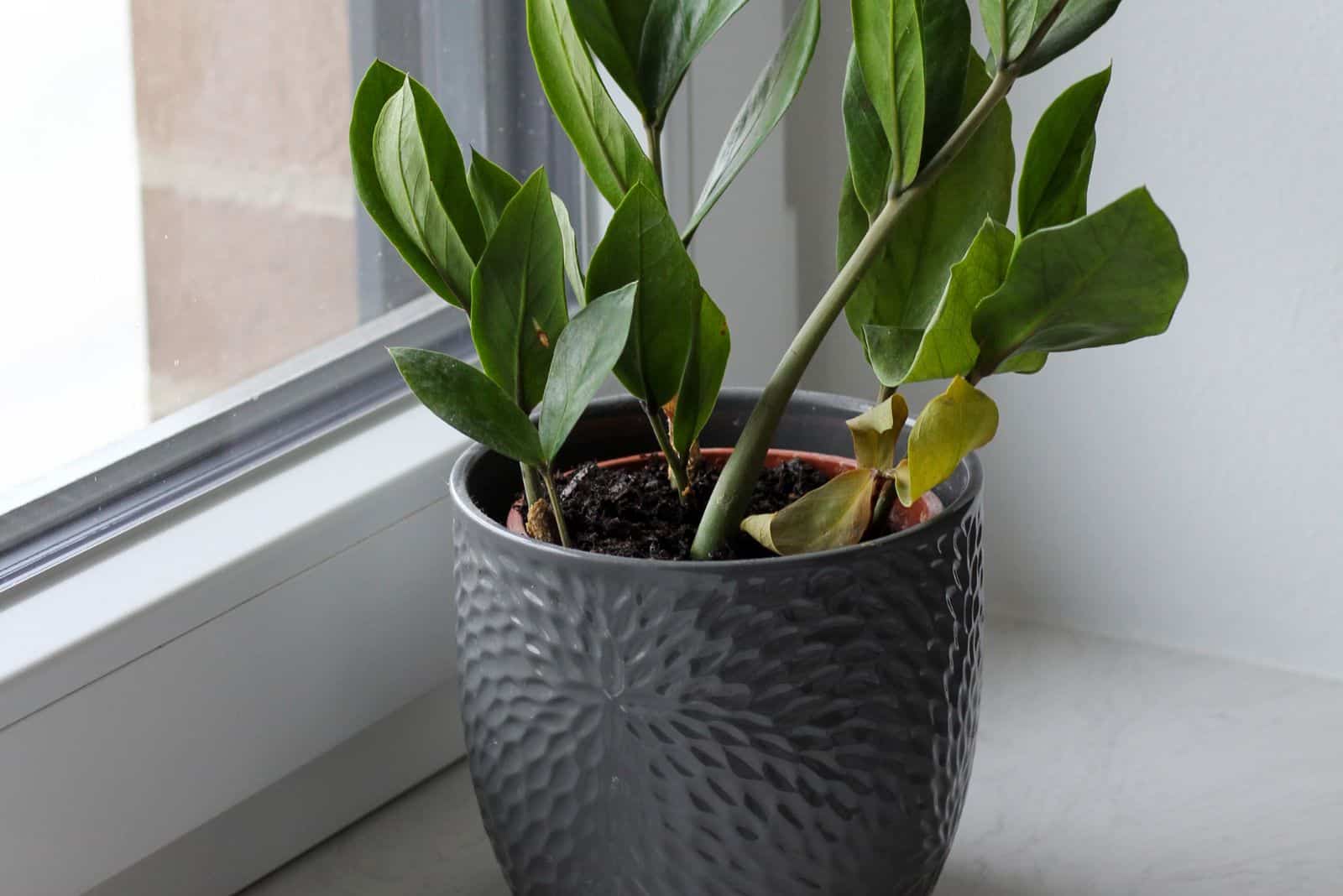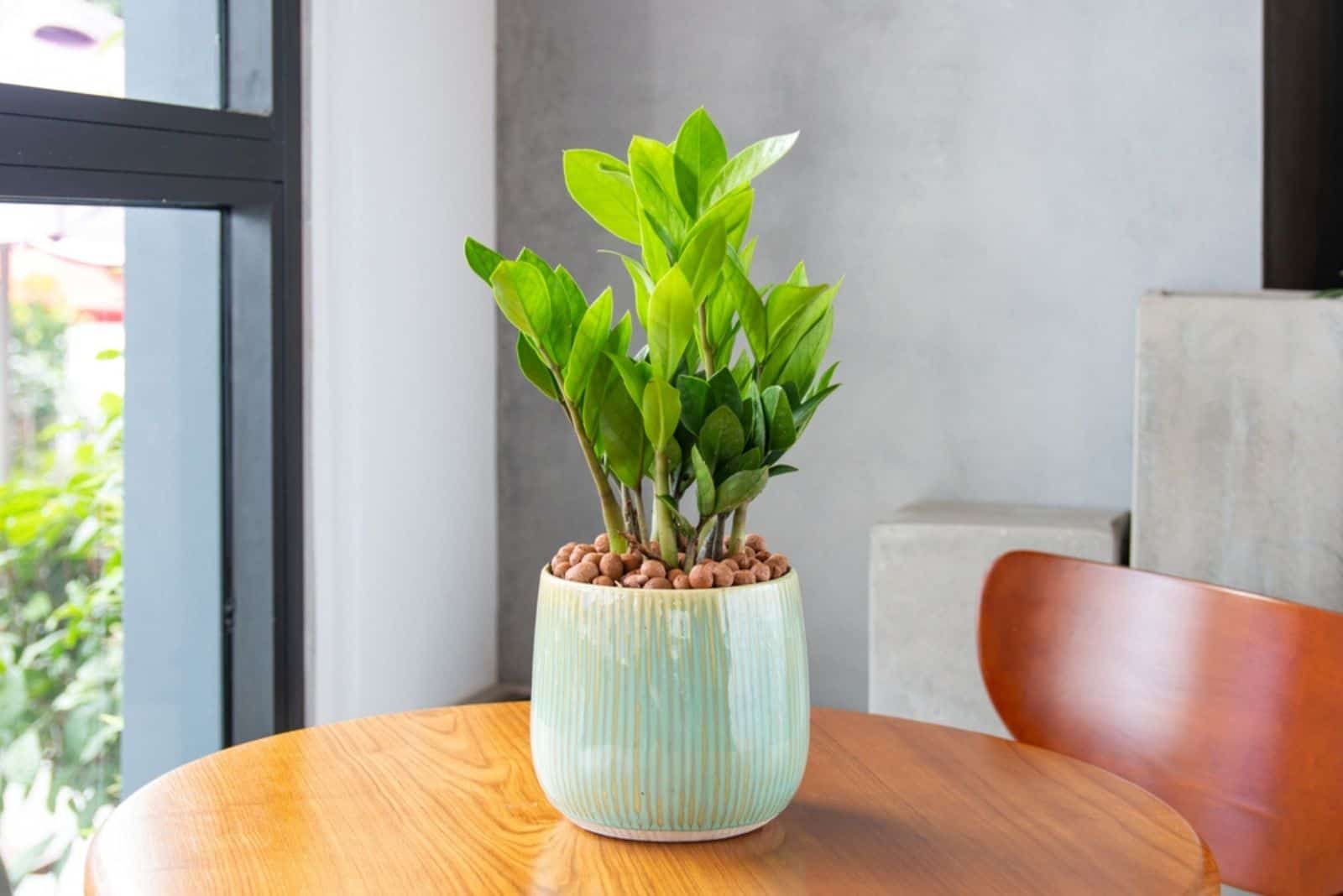The ZZ plant is one of the most popular indoor plants of all time due to its low-maintenance requirements. Its dark green foliage requires very little care to shine, and it works great for all sorts of settings.
The ZZ plant is a low-light indoor plant, so you can even take it with you to your office where it’ll thrive under those fluorescent lights.
This plant can store water in its rhizomes, so you don’t have to worry if you sometimes forget to irrigate it.
Of course, light and water aren’t its only requirements, so we’ll discuss all the things you need to know about ZZ plant care in order to keep it healthy and thriving.
And to help you out with any potential issues, we included a section dedicated to its common problems, such as pests and diseases, droopiness, and leaf discolorations, as well as how to solve them.
Finally, we’ll present a couple of popular ZZ plants so that you can include more of them in your indoor decor.
Before we get to all that, let’s learn some specifics about this green gem:
| Family: | Araceae |
| Genus: | Zamioculcas |
| Scientific name: | Zamioculcas zamiifolia |
| Common names: | ZZ plant, Zanzibar gem, zuzu plant, eternity plant, aroid palm, emerald palm |
| Plant type: | Perennial |
| Native habitat: | East Africa |
| Size: | 2-4 feet tall (sometimes 5 feet) |
| Growing season: | Spring through fall |
| USDA hardiness zone: | 9-12 |
ZZ Plant Care
The ZZ plant is great for feng shui, although you should be careful about its placement since too much direct sun can hurt its gentle foliage.
In addition to that, ensure the growing medium is moist but never wet, feed it occasionally, and choose a well-draining plant soil.
These are just some of the basic requirements, and below, you will find detailed ZZ plant care instructions.
Light Requirements
The Zanzibar gem thrives in bright indirect sunlight, although it can tolerate low-light conditions quite well.
Of course, you shouldn’t expose it to complete darkness either, but make sure to keep it away from direct sunlight since it can burn its foliage.
The best location for ZZ plants are eastern or southern windowsills, where they’ll get plenty of direct sun in the morning or late afternoon, but won’t get sunburnt since the UV rays aren’t that harsh.
You can also place it under grow lights if you have no other option, but make sure they’re at least 1-1.5 feet away to avoid burning. (Some lamps can generate a lot of heat, which can also hurt your plant’s foliage).
Finally, if all you have to choose from are west-facing windowsills, you don’t have to say goodbye to your zuzu plant; simply close the curtains or move your Zanzibar gem 2-3 feet away from the window and it will get just the right amount of light.
Water And Humidity
Inadequate watering is one of the main causes of black spots on your ZZ plant leaves, which is why you should make sure to irrigate it only when it needs more moisture.
Generally speaking, you can get by with watering this Zanzibar gem every 2-3 weeks, but that greatly depends on its other growing conditions.
If you keep it in bright light and a loose growing medium it’ll need more moisture, unlike plants in shadier locations and heavier potting soils. Also, plants require less moisture during dormancy, so bear that in mind once winter comes.
Some signs that your ZZ plant requires more water are droopiness, wrinkly leaves, and dry soil. Actually, once the top potting mix dries out, you should moisturize your plant.
This aroid palm is a drought tolerant plant, so it doesn’t mind being underwatered. Excess water in the soil, on the other hand, is quite uncomfortable for it and can lead to root rot.
Finally, water your ZZ plant in the morning or late afternoon with distilled or rainwater because they don’t contain chlorine or fluoride, which can build up and hinder the normal absorption of moisture and nutrients.
Humidity
This plant is really not that picky about air moisture and can thrive in moderate and even low humidity levels.
If you want to create perfect growing conditions for this plant, keep your indoor humidity at around 40-50%.
The best way to achieve this is with a humidifier or by misting (if the average humidity in your home is below the preferred level). We tried the pebble tray method on our other plants and it wasn’t that successful.
We must mention that particularly humid environments can put your plant in danger of pest infestations, so we wouldn’t recommend keeping the air moisture levels above 70-80%.
Temperature
This eternity plant flourishes in temperatures between 60 and 75 degrees Fahrenheit, although it can grow just as well in temperatures up to 85 degrees.
However, it doesn’t like the cold, so make sure not to keep it in temperatures below 45 degrees Fahrenheit since such cold conditions can really hurt your ZZ.
You should also avoid keeping it in drafty locations, such as near heaters, air conditioners, old windows, doors, hallways, etc., since they experience temperature swings and can stress out your plant.
The air is also drier due to drafts, which may cause additional problems.
Soil And Fertilizer
The best potting soil for ZZ plants is light and loose, well-draining, and with a neutral or slightly acidic pH level between 6.0-7.0.
You can get a ready-made mix online, in your garden center, or by making your own. We’ve made quite a few blends, and we usually use the materials we have left from other plants.
For instance, you can make a well-draining soil mix for your ZZ plant by combining equal parts coco coir (or peat moss if you have that) and regular potting soil, and double the amount of perlite or pumice (or a combination of the two).
If you have some cactus or succulent mix left, you can add one part of that, three parts regular potting medium, and some compost to improve drainage and water retention, as well as add some nutrients into the picture.
And if you feel that it requires more drainage, you can always add some pumice, perlite, or horticultural sand.
Of course, you can use cactus or succulent mix on its own, but you might need to irrigate your plant a bit more frequently as they are super well-draining.
Fertilizer
One of the best things about the ZZ plant is the fact that it doesn’t require any additional fertilizers to thrive.
However, if you want to give it an additional boost, you can use diluted triple 5 or triple 10 twice during its growing season.
Don’t feed your green buddy during dormancy since it doesn’t require nutrients at that time, and more minerals would only burn its roots and waste product.
Repotting
When repotting, you might notice a ZZ plant bulb or round rhizome, which you can either separate or just leave be.
But when should you repot this eternity plant?
ZZ plants have a slow growth rate, so you can move them to a new container every two years or so.
The best time to repot this emerald gem is in spring or early summer since the plant will have more than enough time to recover from the transplant shock before dormancy.
When choosing a new pot for your zuzu plant, always go for a container 1-2 sizes larger than the previous one (if your plant has doubled in size) so that its roots have room to grow.
Get a terracotta planter with drainage holes since these provide optimal drainage and reduce the risk of root rot.
Then, put some potting medium in the bottom of the pot, place your ZZ plant in it, and fill the container with more substrate.
Water your plant deeply (if you notice that the previous potting soil was soaking wet and there is some root rot going on, don’t), and place your Zanzibar gem in a location with bright indirect light.
And if you need more information about how to repot ZZ plants, you can just watch this handy video:
Pruning
A ZZ plant is one of the best choices for beginners as it requires little to no pruning. It shapes itself perfectly well and doesn’t take up too much space, so you won’t need to do any extensive trimming.
However, you should remove old, discolored, and diseased foliage since they taint the plant’s overall appearance, waste its energy, and can even weaken it (if some foliar disease is taking place). As a result, your ZZ will not develop further.
Removing dying leaves and stems will stop the plant from wasting energy on getting them better and will make it focus on pushing out new and healthy growth.
Propagation
There are quite a few methods and techniques for zuzu plant propagation: leaf cuttings, stem cuttings, and division.
Since the plant grows in clusters, each of which has a bulb or thickened rhizome, you can easily divide them to get more new plants.
The leaf and stem cutting methods are just a tad bit more complicated, so we’ll explain them separately.
Propagation By Stem Cuttings
Propagating ZZ plants through stem cuttings is much more common (not to mention easier) than multiplying them by leaf cuttings, so we’ll discuss this method first.
Step 1. Choose a healthy stem and cut it to the base of the plant with sterilized pruners. You can take just a couple of inches, but once you make an incision, that stem won’t continue to grow and will look like an eyesore.
Step 2. Leave the cuttings for about a day or so to form a callus. (You’ll notice that the incision has dried out, and that’s your cue to continue.)
Step 3. Plant the cut stem in well-draining soil and water it deeply.
Step 4. Expose your cuttings to bright indirect light, ensure that the potting substrate is never dry, and that’s it!
You can also propagate stem cuttings in water, although you will have to change the medium every couple of days or whenever it gets foggy. Also make sure to submerge just a small portion of the plant.
Note: These plants take a really long time to root, so don’t be disappointed if you can’t see anything concrete after a month. After about two months, you’ll definitely notice tiny roots growing.
Here is some more ZZ plant propagation advice:
Propagation By Leaf Cuttings
Step 1. Find a spot where the leaf is connected to the stem and cut it right there. You can take a couple of leaves to increase the success rate.
Step 2. Let foliage sit for a couple of hours to form a callus, which may help with rooting.
Step 3. Plant the cutting in a nursery tray filled with moist and well-draining soil mix.
Step 4. You can put a humidity dome or a plastic bag over them to increase the humidity, which helps with rooting. You should also make sure that the growing medium is never completely dry.
Step 5. Expose your ZZ plant leaf cuttings to indirect sunlight and warm temperatures for faster root development.
Step 6. Once the cuttings start putting on new growth and you can see their roots protruding from the drainage holes of your nursery tray, you can transplant them to a larger container.
* You can also root the leaf cuttings in water, but you’ll need to change it every couple of days and make sure that only the cut part is submerged.
Common Issues
ZZ plants are quite resilient and they rarely succumb to infestations and infections. However, it can happen, which is why we’ll include all the common issues that may affect your Zanzibar gem.
Some of them are brown and yellow leaves, wilting, root rot, and common houseplant pests.
Luckily, we have a solution for each of these problems down below!
Pests
Even though the eternity plant isn’t that susceptible to infestations, pests such as brown scales, aphids, mealybugs, spider mites, etc., can attack it.
Therefore, it is important to check on your plant regularly and deal with bugs as soon as you notice them.
If the infestation is small, you can remove them with a swab drenched in rubbing alcohol (just make sure not to touch your plant or it might burn it).
And if there are large insect colonies parading over your ZZ plant, you can simply spray them with some insecticidal soap or horticultural oils.
Diseases
The most common disease that afflicts these plants is root rot. We’ve got used to talking and hearing about it, but it’s a serious issue for your plants and can kill them if you don’t catch it in time.
Root rot is manifested by yellow leaves, wilting, stunted growth, and, in the worst case, a rotting smell spreading from the pot (that’s when you know you messed up!).
When you notice any of these symptoms, examine the plant’s roots. Remove the dirt around them and if they’re soft, soggy, brown, or black, you should cut them.
Afterwards, you can spray some broad-spectrum fungicide (although, this is optional), repot your plant, and let it go 1-2 weeks without water (it has more than enough stored in its tubers).
And if the entire root system is rotten, but some stems are still holding on, you can propagate either them or the leaves.
Droopiness
The most common causes of a ZZ plant drooping are inadequate watering and sunlight, cold temperatures, lack of nutrients, transplant shock, and bound roots.
And since there are many reasons for these issues, you have to take each of them into consideration and cross them off one by one until you’re left with the most likely culprit.
For instance, if the soil is soaking wet, the issue is probably overwatering. If you can’t remember the last time you watered your plant or you keep it in direct sunlight, you should move it to a shadier location and irrigate it.
If it’s been more than 2-3 years since you repotted your plant, you should do it immediately since root bound plants cannot absorb moisture and nutrients properly.
If you’re cold, your plant’s cold; if you’ve just repotted it, it’s transplant shock, etc.
What we want to say is that you have to monitor your plant regularly, feel the temperature in the room, check the light it gets, etc. because all these things can help your droopy Zanzibar gem come back to life!
Leaf Discolorations
ZZ plants have bright or dark green leaves (unless you have one of those amazing variegated, white, or golden cultivars).
Therefore, if you notice your plant leaves turning yellow, check its light conditions. Too much direct sunlight will lead to burning manifested as yellowing and browning of the foliage.
And low-light conditions will make your ZZ plant pale, yellow, and even leggy.
Lack of nitrogen can also lead to yellow leaves, so remember to apply fertilizer twice a year and repot your plant every two years. Regular repotting can replenish essential nutrients and keep your plant happy.
Finally, overwatering and root rot also result in leaves turning yellow, so you should water your ZZ plant only when its soil mix dries out (usually once every 2-3 weeks, depending on its growing conditions).
Popular Types Of ZZ Plants
There are many amazing ZZ plant varieties, and below you can find some of the most popular and beautiful ones to incorporate into your decor.
Raven ZZ plant – The unique purple-black foliage of this cultivar make it perfect for any home, not to mention its compact shape and height of 30 inches.
Regular ZZ plant – No one can argue that the classical ZZ plant, with its bright and dark green oval foliage, is less attractive than other species.
Gold variegated ZZ plant – The truly unique golden variegation can overtake entire stems or appear as sprinkled dust on dark green leaves (breathtaking either way).
Zamia Albino – The white or creamy colored leaves of this cultivar are a perfect companion to the raven or regular ZZ plant, and can create an exotic environment.
Dwarf ZZ plant – The dark green leaves of this dwarf cultivar have a special power – they curl backwards and create a unique contrast with your other plants.
FAQ
Are ZZ plants toxic to pets?
Unfortunately, the ZZ plant is poisonous to cats, dogs, and other pets you might have because it contains calcium oxalate crystals in all its parts.
If your pets ingest some leaves or take a bite of the stems, they may experience a burning sensation around their mouth and spit it out, which won’t cause any serious damage.
But if your pet does ingest the leaves, stems, or roots, they’ll experience excessive drooling, nausea, vomiting, diarrhea, swelling in the throat, dehydration, etc.
Therefore, keep these plants in an elevated position or fence them in so pets can’t reach them.
What is the lifespan of a ZZ plant?
The ZZ plant has a long lifespan and can live up to 30 years. It grows rather slowly and usually between 2-3 feet tall indoors, so don’t worry about constant repotting and pruning.
It is low-maintenance, and you might even forget you have it if it weren’t for its mesmerizing foliage.
Final Thoughts
ZZ plant care is quite simple and undemanding. Expose it to indirect light and warmth, water it every 2-3 weeks, and fertilize it only twice a year, and it’ll be fine.
You can increase the air moisture up to 40-50%, but the plant can tolerate lower levels just as well.
You don’t have to prune it regularly, so just repot it every two years and it will thrive with minimal care.
It’s not that susceptible to pests, but it can get infested, so keep an eye out for bugs and treat infestation as soon as you notice it.
Other common issues include root rot, droopiness, and discoloration. The first thing you need to do about them is figure out the cause and then implement treatment.
And finally, there are so many amazing ZZ plant cultivars out there, so we included our five favorites to light up your world.
Until next time!

